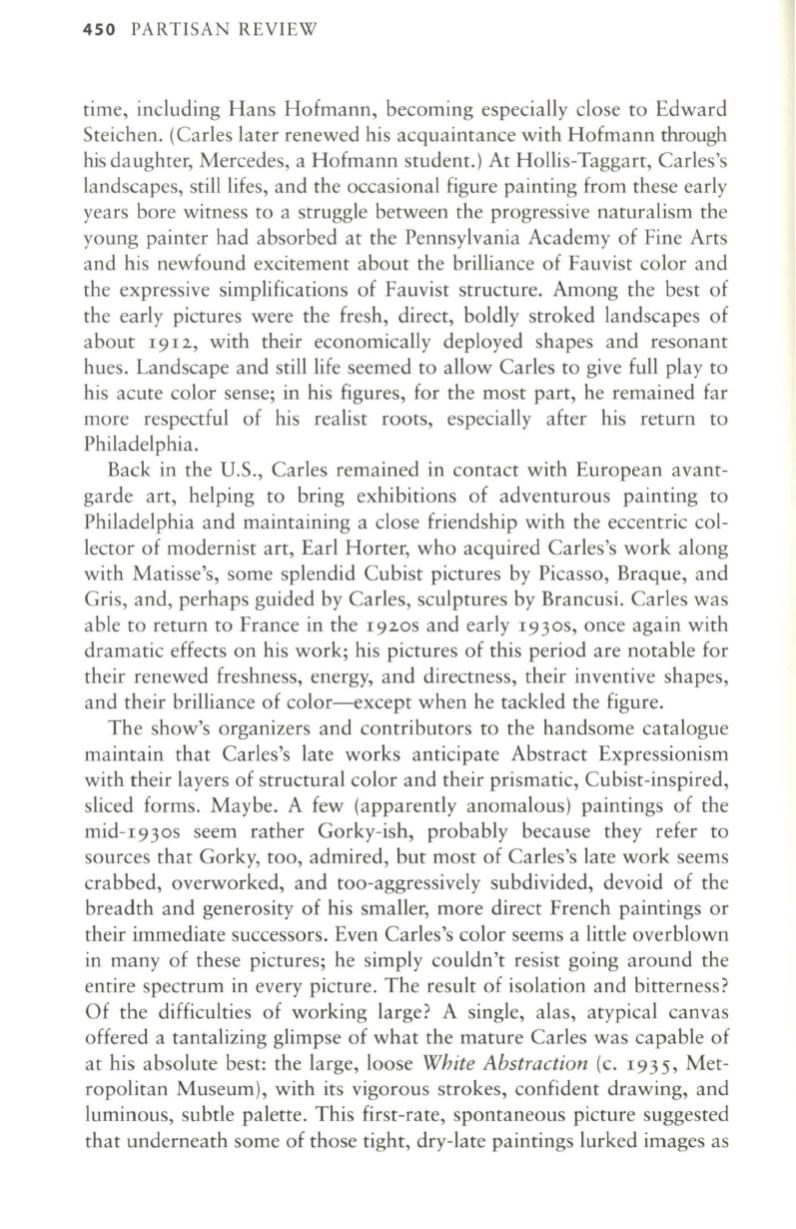
450
PARTISAN REVIEW
time, including Hans Hofmann, becoming especially close to Edward
Steichen. (Carles later renewed his acquaintance with Hofmann through
his daughter, Mercedes, a Hofmann student.) At Hollis-Taggart, Carles's
landscapes, stililifes, and the occasional figure painting from these early
years bore witness to a struggle between the progressive naturalism the
young painter had absorbed at the Pennsylvania Academy of Fine Arts
and his newfound excitement about the brilliance of Fauvist color and
the expressive simplifications of Fauvist structure. Among the best of
the early pictures were the fresh, direct, boldly stroked landscapes of
about 1912, with their economically deployed shapes and resonant
hues. Landscape and still life seemed to allow Carles to give full play to
his acute color sense; in his figures, for the most part, he remained far
more respectful of his realist roots, especially after his return to
Philadelphia.
Back in the U.S., Carles remained in contact with European avant–
garde art, helping to bring exhibitions of adventurous painting to
Philadelphia and maintaining a close friendship with the eccentric col–
lector of modernist art, Earl Horter, who acquired Carles's work along
with Matisse's, some splendid Cubist pictures by Picasso, Braque, and
Gris, and, perhaps guided by Carles, sculptures by Brancusi. Carles was
able to return to France in the 1920S and early 1930S, once again with
dramatic effects on his work; his pictures of this period are notable for
their renewed freshness, energy, and directness, their inventive shapes,
and their brilliance of color-except when he tackled the figure.
The show's organizers and contributors to the handsome catalogue
maintain that Carles's late works anticipate Abstract Expressionism
with their layers of structural color and their prismatic, Cubist-inspired,
sliced forms. Maybe. A few (apparently anomalous) paintings of the
mid-1930S seem rather Gorky-ish, probably because they refer to
sources that Gorky, too, admired, but most of Carles's late work seems
crabbed, overworked, and too-aggressively subdivided, devoid of the
breadth and generosity of his smaller, more direct French paintings or
their immediate successors. Even Carles's color seems a little overblown
in many of these pictures; he simply couldn't resist going around the
entire spectrum in every picture. The result of isolation and bitterness?
Of the difficulties of working large? A single, alas, atypical canvas
offered a tantalizing glimpse of what the mature Carles was capable of
at his absolute best: the large, loose
White Abstraction
(c. 1935, Met–
ropolitan Museum), with its vigorous strokes, confident drawing, and
luminous, subtle palette. This first-rate, spontaneous picture suggested
that underneath some of those tight, dry-late paintings lurked images as


